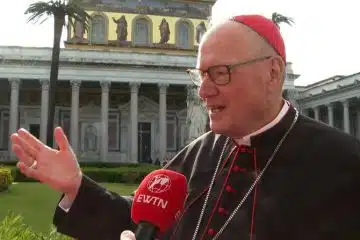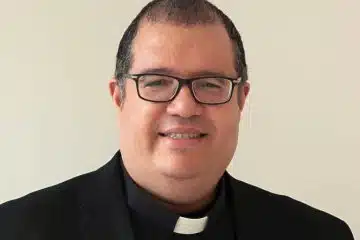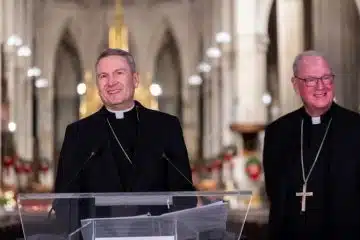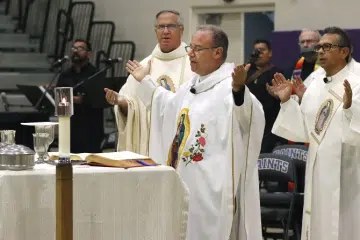At Cincinnati meeting, VOTF discusses support for priests
Friday, July 10, 2009
By Carmen M. Hubbard
ST. ANDREW DEANERY — An advisory board for the national group Voice of the Faithful (VOTF) met recently in Cincinnati to discuss ways in which the group might best offer support for priests and the priesthood.
The June 20 meeting, which included Mass at St. Michael Church in Sharonville, brought together VOTF Goal 2 working group members, as well as Bill D’Antonio, a theologian and an adjunct research professor at Catholic University of America in Washington, DC; Father Donald B. Cozzens, professor of religious studies and a writer in residence at John Carroll University in Cleveland, and Edward Hahnenberg, associate professor of theology at Xavier University.
 |
| Left to right: Bill D’Antonio, Father Donald B. Cozzens and Edward Hahnenberg. (CT/Carmen M. Hubbard) |
VOTF member Dick Okenfuss, a parishioner at St. Bartholomew Church in Finneytown, said the advisory board agreed on an action plan on how to best support priests.
“Our national working group for priest support, the second of the three goals of Voice of the Faithful, was reorganized in October 2006, with mostly new members recruited across the U.S.,” he told The Catholic Telegraph. “We were looking for ways to do more than just honor priests who showed courage by speaking out about the child abuse scandal and other problems facing our church. As an example, in 2005, at our conference in Indianapolis, we honored Msgr. Larry Breslin of Dayton as our ‘Priest of Integrity’ for speaking out against the decision to send an accused predator priest to Rome for further study.”
He said that the group decided it “needed to look for ways to reach all priests, find ways to best support them and the priesthood due to the decline in vocations.” He said that in their research, VOTF learned that “mandatory celibacy was a key issue, affecting the morale of many” priests, and the organization decided to call for “a serious, unbiased review of this requirement,” which it did a year ago.
The group compiled a list of what it calls “key contacts,” “ranging from quite conservative to very liberal, and added names of other theologians, authors, and noted Catholics to come up with a list of over 400 people.” A new website was created, www.nwgps.org, in which questions for discussion were listed.
Okenfuss says that the action plan “is to focus more on key contacts who we believe will help us spread our message to support priests,” he said. “We want to encourage them to speak out on the problems facing the priesthood and hopefully support or offer encouragement for the ideas we are presenting to them.”
The group believes that priests are its target audience, and is offering the website as a forum where they can discuss their concerns without identifying themselves, if they so prefer, he added.
“We are considering a similar forum for theologians. We would love to have bishops join in the discussions. However, raising the understanding of all of the laity that something must be done is, we believe, likely to be more effective,” he said.
The purpose of the VOTF advisory board meeting in Cincinnati was to hear from expert guests about the challenges facing the church and to discuss topics of “importance to our goal of supporting priests,” Okenfuss said.
D’Antonio told the group that there are many young men who are interested in the priesthood, but the restriction of marriage continues to discourage them from entering the seminary.
Father Cozzens said there are probably more priests who are 90 years old than those who are 30 years old. He described 80- and 90-year-old priests as more pastoral than canonical; priests who are in their 40s and younger trust in canon law and are canonical, and those ages 50-60 tend to be more moderate, between pastoral and canonical.
“Young priests don’t talk to older priests. It’s hard to bring them together on a diocesan level and on a national level,” Father Cozzens said.
The panel also examined the immaturity of young priests.
“I think, unconsciously, the seminary retards maturation of men as an adult. Priests tend to be more psychologically immature compared to others their age with the same education who are married, have a mortgage and have children,” Father Cozzens said.
Hahnenberg discussed clustering priests to pastor multiple parishes as a way to alleviate the priest shortage within the church. Assigning a priest to several parishes has been a common strategy for the past 20 years, he said. In doing so, priests aren’t given the resources to manage multiple parishes.
He told the group that the church is in the midst of a change.
“I do think things will get worse before they get better. But who can predict what will come? What will come will be different.” He added that Catholics have been socialized into pacifism, which is why VOTF must determine ways parishioners can have an active role.
Said Dick Okenfuss, “When the opportunity came to have these three distinguished authors join us for a free-flowing discussion of the church, the priesthood and the concerns about the future, we were overjoyed. They gave us the underpinning formula for a theology and spirituality to reform the institutional church.
“We now realize that while availability of the Eucharist for the laity is an issue, and celibacy is an issue, the real issue is “community.” Vatican II said that we are all church. But we still do not act as one on many issues,” he said.
VOTF taped the two-hour panel discussion and hopes to distribute it widely and add it to the group’s website. For more information about Voice of the Faithful, visit their website at: votf.org.









